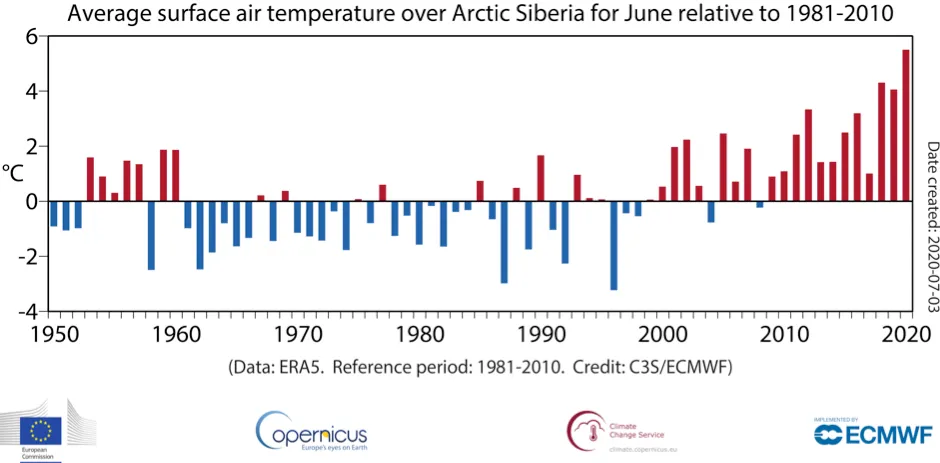Arctic Siberia saw exceptionally high temperatures as global warmth matched last year’s record levels for June, experts have said.
Average temperatures in Arctic Siberia were as high as 10°C above normal for June, according to the Copernicus Climate Change Service (C3S) from the European Centre for Medium Range Weather Forecast (ECMWF).
A month of intense fires in the Arctic Circle have also been recorded by the Copernicus Atmosphere Monitoring Service, surpassing the record levels of fires seen in the region in June 2019.
Globally, last month was on a par with 2019 for the hottest June on record, with temperatures 0.53°C above the 1981 to 2010 average, and Europe saw its joint second warmest June on record.
Temperatures in Arctic Siberia were exceptionally warm, C3S experts said.
Average temperatures were as high as 10°C above normal for the month in some places, while across all land in the region, temperatures averaged more than 5°C higher than usual and more than 1°C above 2018 and 2019 – the two previous warmest Junes.
Regional variation saw western Siberia experience mainly below-average temperatures in June, despite having a long period of warmer than usual temperatures stretching back to December.
In eastern Siberia, C3S, which uses satellite observations, estimated a maximum hourly Arctic temperature of 37°C on 20 June, in the area where a recording station reported a record temperature of 38°C on the same day – although that has not yet been confirmed.
Director of the C3S at ECMWF, Carlo Buontempo, said: “Finding what caused these record temperatures is not a straightforward endeavour as there are many contributing factors interacting with each other.
“Siberia and the Arctic Circle in general have large fluctuations from year to year and have experienced other relatively warm Junes before."
Read more about climate change:
- May 2020 global temperatures hottest on record
- Global temperature rise must be kept under 2°C to protect tropical forests
- Rapid Ice Age retreat of Antarctic ice gives stark climate change warning
“What is worrisome is that the Arctic is warming faster than the rest of the world," said Buontempo.
“Western Siberia experiencing warmer-than-average temperatures so long during the winter and spring is unusual, and the exceptionally high temperatures in Arctic Siberia that have occurred now in June 2020 are equally a cause for concern.”
The higher temperatures and dry soils have contributed to increased fire activity, mostly in the far north-east of Siberia.
Scientists from the Copernicus Atmosphere Monitoring Service, also implemented by ECMWF, said the number and intensity of wildfires in parts of north-eastern Russia, and to a lesser degree in Alaska and Canada’s Yukon Territory, had been increasing since the second week in June.
The burning fires had resulted in the highest estimated emissions in 18 years of monitoring, with an estimated 59 million tonnes of carbon dioxide released into the atmosphere in June, more than last June’s total of 53 million tonnes.

Experts at the Met Office said the high temperatures in northern Eurasia were due to a combination of climate change and extreme climate variability.
A climate phenomenon known as the Indian Ocean dipole, with different sea surface temperatures in different parts of the ocean, saw record extremes in the autumn, helping create the conditions to push up temperatures in the region in winter and into spring.
Climate change is also melting the sea ice, creating areas where heat from the Sun is absorbed by the dark ocean water rather than being reflected by ice and snow, amplifying the warmth in the Arctic.
Reader Q&A: Do we really know what climate change will do to our planet?
Asked by: Jennifer Cowsill, via email
There is no doubt that greenhouse gas emissions caused by humans are changing our climate, resulting in a progressive rise in global average temperatures. The scientific consensus on this is comparable to the scientific consensus that smoking causes lung cancer.
Our climate is a hugely intricate system of interlinking processes, so forecasting exactly how this temperature increase will play out across the globe is a complex task. Scientists base their predictions on powerful computer models that combine our understanding of climatic processes with past climate data.
Many large-scale trends can now be calculated with a high degree of certainty: for instance, warmer temperatures will cause seawater to expand and glaciers to melt, resulting in higher sea levels and flooding. More localised predictions are often subject to greater uncertainty.
Read more:
